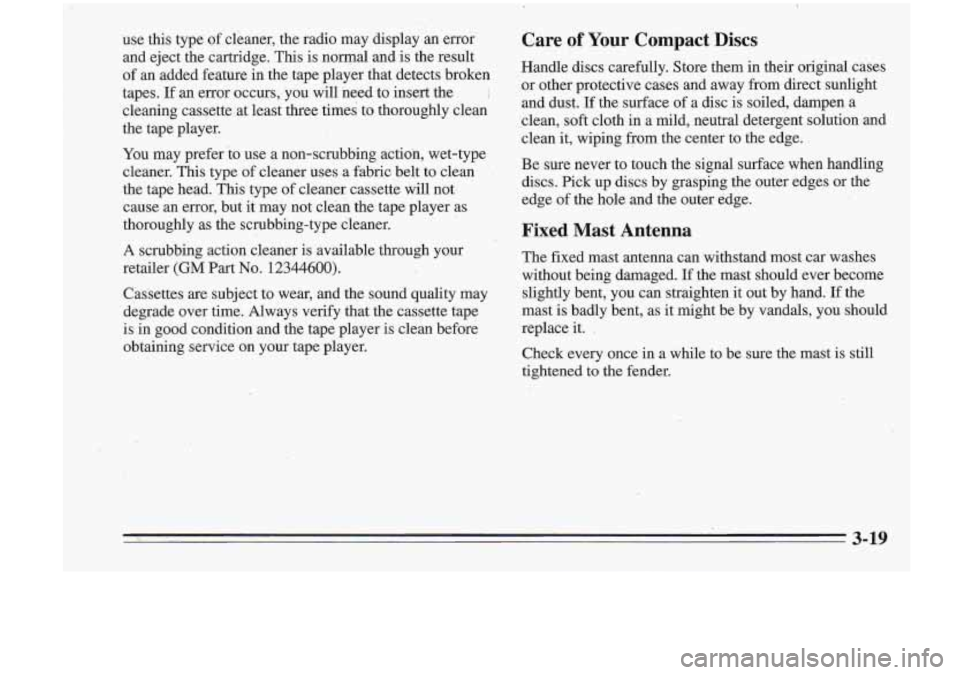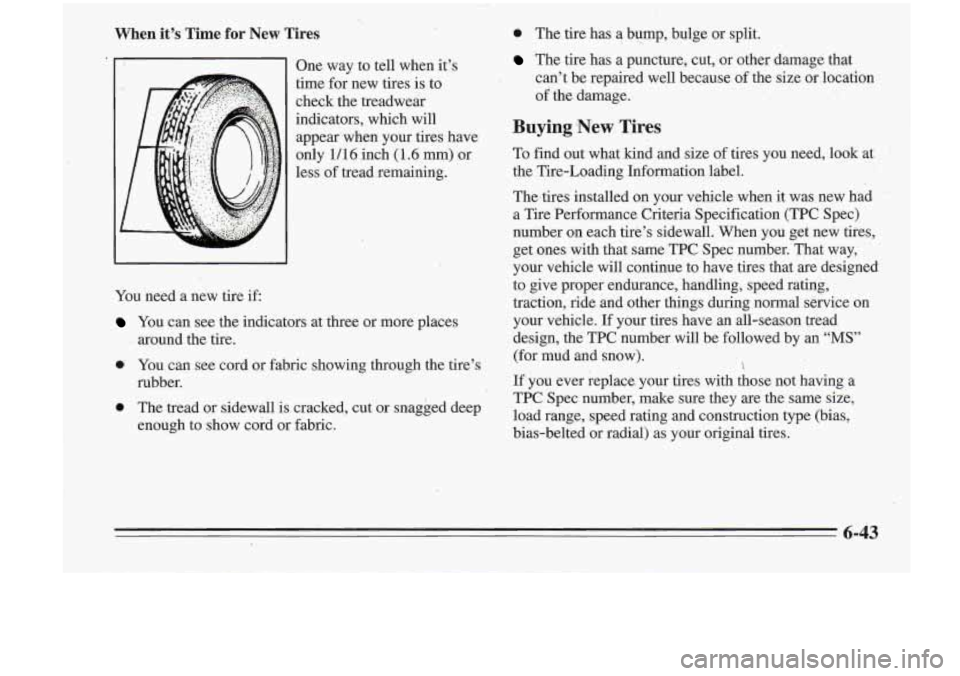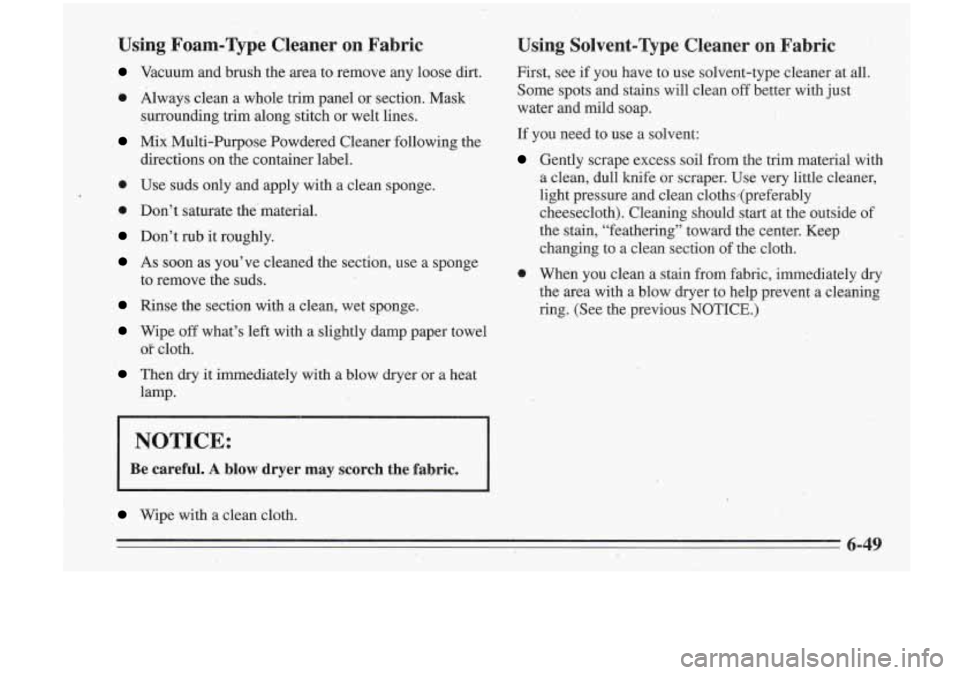Page 135 of 340

use this type of cleaner, the radio may display an error'
and eject the cartridge.
This is nongal and is the result
of an added feature in the tape player that detects broken
tapes.
If an error occurs, you will need to insert the ;
cleaning cassette at least three times to thoroughly clean
the tape player.
You may prefer to use a non-scrubbing action, wet-type
cleaner.
This type of cleaner uses a fabrio belt to clean
the tape head. This type of cleaner cassette will not-
cause an error, but it may not ckan the tape player as
thoroughly as the scrubbing-type cleaner.
n scrubbing action cleaner is available through your
retailer
(GM Part No. 12344600).
Cassettes are subject 'to wear, and the sound quality may
degrade over time. Always verify that the cassette tape
is
in good condition and the tape player is clean before
obtaining service on your tape player.
Care of Your Compact Discs
Handle discs carefully. Store them in th,eir original cases
or other protective cases and away from direct sunlight
and dust.
If the surface of a disc is soiled, dampen a
clean, soft cloth ,in
a mild, neutral detergent solution and
clean it, wiping from the center to the edge.
Be sure never to touch the signal surface when handling
discs. Pick up discs by grasping the outer edges
or the
edge of the hole and the outer edge.
Fixed Mast Antenna
The fixed mast antenna can withstand most car washes
without being damaged.
If the mast should ever become
slightly bent, you can straighten it out by hand. If the
mast
is badly bent, as it might be by van.dals, you should
replace it.
I
Check every once in a while to be sure the mast is still
tightened to the fender.
3-19
Page 247 of 340

‘\..
When it’s Time for New Tires
One way to tell when it’s
time for new tires
is to
check the treadwear
indicators, which will appear’ when your tires have
only
1/16 inch (1.6 mm) or
less of tread remaining.
You need a new
tire if:
You can see the indicators at three or more places
around the tire.
a’ You can see cord or fabric showing through the tire’s ’
rubber. I
0 The tread or sidewall is cracked, cut or snagged deep
enough to show cord or fabric.
0 The tire has a 1 bump, -., bulge or split.
The tire has a puncture, cut, or other damage that
can’t be repaired well because of the
size or location
of the damage.
Buying \New Tires
To find out what kind and size of tires you need, look at
the Tire-Loading Information label.
Theltires installed
on your vehicle .when it was new had
a Tire Performance Criteria Specification (TPC Spec)
number on each tirk’s sidewall. When you get new tires,
get ones with that same TPC Spec number. That way,
your vehicle will coniinue to have tires that are designed- to give proper endurance, handling, speed rating,
traction, ride and other things during normal service on
your vehicle. If your tires have an all-season tread
design, the TPC number will be foilowed by an
“MS”
(for mud and snow).
If you ever replace, your tires with those not having a
TPC Spec number, make sure they are the same size,
load range, speed rating and construction type (bias,
bias-belted or radial) as your original tires.
Page 253 of 340

Using Foam-Type. Cleaner on Fabric
Vacuum and brush the area to remove any loose dirt.
Always clean a whole trim panel or section. Mask
surrounding trim along stitch or welt lines.
directions on the container label.
Mix Multi-Purpose Powdered Cleaner following the
@ Use suds only and apply with a clean sponge.
@ Don’t saturate the’material.
Don’t rub it roughly.
As soon as you’ve cleaned the section, use a sponge
to remove the suds.
Rinse the section with a clean, wet sponge.
Wipe off what’s left with a slightly damp paper towel
of cloth.
Then dry it immediately with a blow dryer or a heat
lamp.
NOTICE:
Be careful. A blow dryer may scorch the fabric.
Wipe with a clean cloth.
Using Solvent-Type Cleaner on Fabric
First, see if you have to use solvent-type cleaner at all.
Some spots and stains will clean off better with just
water and mild soap.
If you need to use a solvent:
Gently scxape excess soil from the trim material with
a clean, dull knife or scraper. Use very little cleaner,
light pressure and clean cloths/(preferably
cheesecloth). Cleaning should start at the outside of
the stain, “feathering” toward the center. Keep
changing to a clean section of the cloth.
e When you clean a stain from fabric, immediately dry
the area with a blow dryer to help prevent a cleaning
ring. (See the;previous
NOTICE.)
6-49